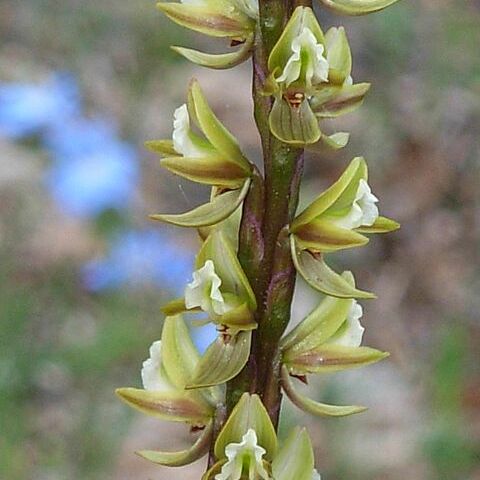Prasophyllum sens. lat., as recognised by the Australian Plant Census [CHAH (2018), accessed 6 December 2022], includes the following descriptions from Jones (2021): Prasophyllum: deciduous, terrestrial, tuberous orchids growing in clonal colonies, less commonly as scattered individuals. Leaf single, leek-like, thin, hollow, usually pink to red-purple at the base. In flowering plants the developing inflorescence grows up inside the leaf and breaks through at a weak point (fistula) in the longitudinal seam of the leaf, leaving the apical lamina free. Inflorescence a sparse to dense spike or spike-like raceme, few to multiflowered. Flowers non-resupinate, dull-coloured, usually opening widely, often scented, each flower perched on the end of a long, slender, sessile or shortly stalked ovary appressed close to the flower stem. Dorsal sepal free, broader than lateral sepals, recurved or incurved and hooding the column. Lateral sepals usually fused to form a synsepalum, erect behind the labellum. Petals free, narrow, more colourful than the sepals, incurved or divergent. Labellum immoveably fixed to the anterior base of the column by a short, immobile claw. Labellum lamina unlobed, large, conspicuous, recurved near the middle, basal margins entire, distal margins strongly wavy or crinkled. Callus a large, fleshy plate on the upper labellum surface, often wet and shiny (with nectar), often a different colour to the labellum, base sunken or basin-like, central part part grooved or channelled, margins extended like flanges or extra ridges. Column short (not much longer than wide), without a basal foot; 2 erect, wing-like lobes flank the anther and stigma. Pollinia 4, sectile, yellow, attached via a hamulus to the viscidium. Paraprasophyllum: tuberous, terrestrial orchids vegetatively and morphologically similar to species of Prasophyllum, but reproducing mainly by seed and with a short ovary about as wide as long and projecting at a steep angle out from the flower stem. Leaf single, hollow; developing inflorescence breaking through the leaf in a similar way to Prasophyllum. Plant size more variable, ranging from short, slender species to tall, robust plants, but none as tall as the imperial species of Prasophyllum from W.A. Many species have colourful flowers that open widely and are scented, but some species lack any apparent scent and a few species have flowers that open tardily or remain closed. The floral parts are basically similar in both Prasophyllum and Paraprasophyllum. Lateral sepals free or partially fused, often breaking free, less commonly forming a fused synsepalum. Petals narrow to flared, often broader and more colourful than in Prasophyllum. Labellum prominent, often white or colourful; margins often more intensely crisped, crinkled or wavy. Column and pollinarium similar to Prasophyllum.
More
Raceme of few to many fls; floral bracts small, much < ovary. Per. glab., labellum uppermost; dorsal sepal concave or recurved; lateral sepals narrower, connate to free; petals us. shorter. Labellum ± trulliform, us. erect and concave towards base, recurved distally, sts movable on well-developed claw; calli on limb simple and ± longitudinal. Column short; wings in form of 2 free lateral processes; anther dorsal, erect, little taller than stigma; pollinia ± bilobed in each cell, pollen in ∞ small oblong masses; stigma disc-shaped; rostellum prominent, becoming detached with thread-like stipe to which pollen-masses adhere. Plants terrestrial, glab.; tuber oval, us. produced close to that of previous year. Lf solitary; sheath long; lamina terete, ± hollow, sts very small. Genus of c. 80–100 described spp., the majority Australian, a few in New Caledonia. The relationship of the N.Z. spp. to those in Australia remains obscure pending a critical review of the whole genus.
These orchids commonly grow in areas of reliable rainfall in coastal and near-coastal areas; they occur much less frequently in drier situations further inland. Overall the genus ranges from the coast to inland areas and montane and alpine regions. They usually grow among shrubs, grasses and sedges in heath, forests, woodlands, shrublands, swamps, bogs, depressions, drainage lines and seepage sites.

